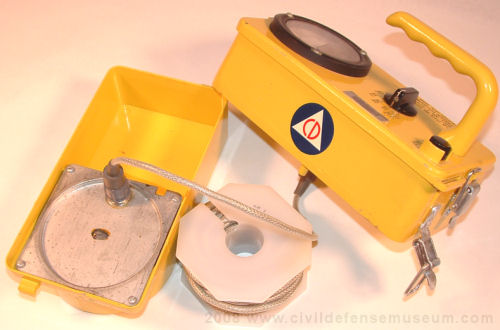
CD V-717
Survey Meter
CD V Stuff Main
Radiation Kits
CD V-777 Kit
CD V-777A Kit
CD V-777-1 Kit
CD V-777-2 Kit
CD V-777-4 Kit
CD V-755
High School Kit
Radiation Instruments
CD V-700
CD V-700
Prototypes
CD V-710
CD V-711
CD V-715
CD V-717
CD V-718
CD V-720
CD V-750 and Dosimeters
Other Sets
CD V-781
Aerial Set
CD V-757
Barrier Set
CD V-457
Class Set
Commercially
Sold Radiation Meters
Low Range
High Range
Comparison
Two State
RADEF Shops
Supplies Main
Back to Civil Defense Museum Main
CD V-717 Survey Meter



CD V-717 Description From the Radiological Defense Planning And Operations Guide Revised March 1967
CD V-717, remote sensor survey meter, is essentially and CD V-715
gamma survey meter with a removable detector unit for making remote measurements
to distances of 25 feet. The ranges of this instrument is 0-0.5, 0-5, 0-50
and 0-500 r/hr. When properly calibrated, the response is within the range of
plus or minus 20 percent of the true gamma dose rate from cobalt 60 or cesium
137 when the cable is connected for remote sensor use. The instrument response
is within plus or minus 5 percent of the meter indication when the cable is not
in the circuit. This instrument is for use by radiological monitors in monitoring
stations during the early period following a nuclear attack. The instrument
was designed to decrease the radiation exposure to the monitor by enabling
to obtain outside dose rate readings while utilizing the protection of some
portion of the structure.
(A webmaster comment: It's interesting to note the difference in the tolerance of plus or minus
20 percent with the cable in the circuit and plus or minus 5 percent without
the cable out of the circuit.)
The metal-cased meter unit seen in these CD V-717 photos was the more durable ruggedized meter and can easily be indentified by the larger black frame around the face of the meter. I have a couple of CD V-715s with these metal-cased meters in them. I have seen mentions that these meters being more durable were also to reduce EMP (Electromagnetic Pulse) effects on the internal electronics of the instrument. I haven't found any information about the metal-cased meter's effect on EMP in any of the FEMA/Civil Defense documents that I have. The FEMA CPG 4-1 Volume 3 states that "The CD V-717-1 uses a ruggedized metal-cased meter to meet the instrument requirements for water-tightness, shock, and vibration resistance." The parts substitution chapter in FEMA CPG 4-1, Volume 10 states that "The metal cased meter used on the CD V-717 model 1 may be used to replace any CD V-715 or CD V-720 meter where a more durable meter is desired." This sounds to me like the CD V-717 was the only instrument originally equipped with the metal cased ruggedized meter.